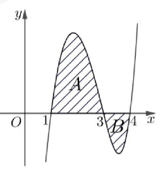Cho hàm số f(x) liên tục trên \(\mathbb{R}\) và \[\mathop \smallint \limits_1^9 \frac{{f\left( {\sqrt x } \right)}}{{\sqrt x }}{\rm{d}}x = 4,\mathop \smallint \limits_0^{\frac{\pi }{2}} f\left( {\sin x} \right)\cos x{\rm{d}}x = 2\]. Tính tích phân \[I = \mathop \smallint \limits_0^3 f\left( x \right){\rm{d}}x\]
A.\[I = 6.\]
B. \[I = 4.\]
C. \[I = 10.\]
D. \[I = 2.\]
 Giải bởi qa.haylamdo.com
Giải bởi qa.haylamdo.com
Xét tích phân\[\mathop \smallint \limits_1^9 \frac{{f\left( {\sqrt x } \right)}}{{\sqrt x }}{\rm{d}}x = 4\]
Đặt\[t = \sqrt x \Rightarrow {t^2} = x \Rightarrow 2tdt = dx\]
Đổi cận:\(\left\{ {\begin{array}{*{20}{c}}{x = 1 \Rightarrow t = 1}\\{x = 9 \Rightarrow t = 3}\end{array}} \right.\)
Khi đó ta có: \[\mathop \smallint \limits_1^9 \frac{{f\left( {\sqrt x } \right)}}{{\sqrt x }}{\rm{d}}x = \mathop \smallint \limits_1^3 \frac{{f\left( t \right)2tdt}}{t} = 2\mathop \smallint \limits_1^3 f\left( t \right)dt = 2\mathop \smallint \limits_1^3 f\left( x \right)dx\]
\[ \Rightarrow 2\mathop \smallint \limits_1^3 f\left( x \right)dx = 4 \Leftrightarrow \mathop \smallint \limits_1^3 f\left( x \right)dx = 2\]
Xét tích phân\[\mathop \smallint \limits_0^{\frac{\pi }{2}} f\left( {\sin x} \right)\cos x{\rm{d}}x = 2\]
Đặt\[u = \sin x \Rightarrow du = \cos xdx\]
Đổi cận:\(\left\{ {\begin{array}{*{20}{c}}{x = 0 \Rightarrow u = 0}\\{x = \frac{\pi }{2} \Rightarrow u = 1}\end{array}} \right.\)
Khi đó ta có:\[\mathop \smallint \limits_0^{\frac{\pi }{2}} f\left( {\sin x} \right)\cos x{\rm{d}}x = \mathop \smallint \limits_0^1 f\left( u \right)du = \mathop \smallint \limits_0^1 f\left( x \right)dx = 2\]
Vậy \[I = \mathop \smallint \limits_0^3 f\left( x \right){\rm{d}}x = \mathop \smallint \limits_0^1 f\left( x \right){\rm{d}}x + \mathop \smallint \limits_1^3 f\left( x \right){\rm{d}}x = 2 + 2 = 4\]
Đáp án cần chọn là: B
Cho hàm số y=f(x) có đồ thị như hình vẽ. Biết các miền A và B có diện tích lần lượt là 4 và 1. Tính \[I = \mathop \smallint \limits_1^2 4xf\left( {{x^2}} \right)dx\]

Tính tích phân \[I = \mathop \smallint \limits_0^\pi {\cos ^3}x\sin xdx\]
Đặt \[\cos x = t \Rightarrow - \sin xdx = dt \Rightarrow \sin xdx = - dt\]
Đổi cận:\(\left\{ {\begin{array}{*{20}{c}}{x = 0 \Rightarrow t = 1}\\{x = \pi \Rightarrow t = - 1}\end{array}} \right.\)
\( \Rightarrow I = - \int\limits_1^{ - 1} {{t^3}dt = } \int\limits_{ - 1}^1 {{t^3}dt = \frac{{{t^4}}}{4}} \left| {_{ - 1}^1} \right. = \frac{1}{4} - \frac{1}{4} = 0\)
Hàm số y=f(x) có nguyên hàm trên (a;b) đồng thời thỏa mãn f(a)=f(b). Lựa chọn phương án đúng:
Cho \[2\sqrt 3 m - \mathop \smallint \limits_0^1 \frac{{4{x^3}}}{{{{\left( {{x^4} + 2} \right)}^2}}}dx = 0\]. Khi đó \[144{m^2} - 1\;\]bằng:
Cho tích phân \[I = \mathop \smallint \limits_0^{\frac{\pi }{2}} \sin x\sqrt {8 + \cos x} dx\] Đặt \[u = 8 + cosx\] thì kết quả nào sau đây là đúng?
Cho y=f(x) là hàm số lẻ và liên tục trên \[\left[ { - a;a} \right].\]Chọn kết luận đúng:
Cho tích phân \[I = \mathop \smallint \limits_0^{\frac{\pi }{2}} {e^{{{\sin }^2}x}}\sin x{\cos ^3}xdx\]. Nếu đổi biến số \[t = si{n^2}x\] thì:
Đặt\[t = {\sin ^2}x \Rightarrow dt = 2\sin x\cos xdx \Rightarrow \sin x\cos xdx = \frac{1}{2}dt\] và\[{\cos ^2}x = 1 - {\sin ^2}x = 1 - t\]
Đổi cận: \(\left\{ {\begin{array}{*{20}{c}}{x = 0 \Rightarrow t = 0}\\{x = \frac{\pi }{2} \Rightarrow t = 1}\end{array}} \right.\)
Khi đó
\[I = \mathop \smallint \limits_0^{\frac{\pi }{2}} {e^{{{\sin }^2}x}}\sin x{\cos ^3}xdx = \mathop \smallint \limits_0^{\frac{\pi }{2}} {e^{{{\sin }^2}x}}co{s^2}x\sin x\cos xdx = \frac{1}{2}\mathop \smallint \limits_0^1 {e^t}\left( {1 - t} \right)dt\]
\[\mathop \smallint \limits_0^1 \frac{{\pi {x^3} + {2^x} + {\rm{e}}{x^3}{{.2}^x}}}{{\pi + {\rm{e}}{{.2}^x}}}{\rm{d}}x = \frac{1}{m} + \frac{1}{{{\rm{e}}\ln n}}\ln \left( {p + \frac{{\rm{e}}}{{{\rm{e}} + \pi }}} \right)\] với m, n, p là các số nguyên dương. Tính tổng \[S = m + n + p\].
Cho \[\mathop \smallint \nolimits_0^4 f(x)dx = - 1\], tính \(I = \mathop \smallint \limits_0^1 f(4x)dx\):
Tính tích phân \[I = \mathop \smallint \limits_{\ln 2}^{\ln 5} \frac{{{e^{2x}}}}{{\sqrt {{e^x} - 1} }}dx\] bằng phương pháp đổi biến số \[u = \sqrt {{e^x} - 1} \]. Khẳng định nào sau đây là khẳng định đúng?
Cho \[I = \mathop \smallint \limits_1^e \frac{{\sqrt {1 + 3\ln x} }}{x}dx\] và \[t = \sqrt {1 + 3lnx} \;\]. Chọn khẳng định sai trong các khẳng định sau:
Cho hàm số f(x) liên tục trên R và \[\mathop \smallint \limits_{ - 2}^4 f(x)dx = 2\] . Mệnh đề nào sau đây là sai?
Đổi biến \[u = \ln x\] thì tích phân \[I = \mathop \smallint \limits_1^e \frac{{1 - \ln x}}{{{x^2}}}dx\] thành:
Cho \[\mathop \smallint \limits_0^1 f\left( x \right)dx = 1.\]Tính \[I = \mathop \smallint \limits_0^{\frac{\pi }{4}} \left( {2{{\sin }^2}x - 1} \right)f\left( {\sin 2x} \right)dx\]
Đổi biến \[x = 4\sin t\] của tích phân \(I = \int\limits_0^{\sqrt 8 } {\sqrt {16 - {x^2}} } \) ta được: